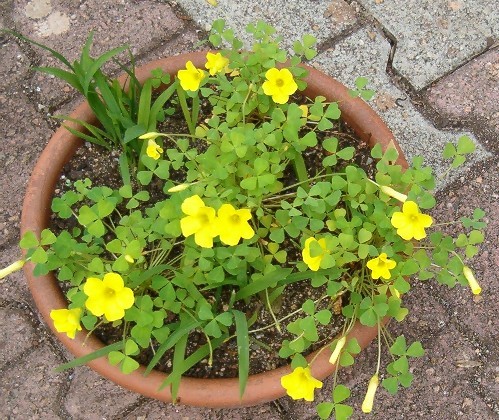 |
Oxalis dentata I acquired by accident.
It was among bulbs that I ordered from South Africa and was lateron
recognised as such by Jim.
It is a free flowering species and it looks very attractive. This
photo I took this morning: 5th december 2006 in a unusually warm
autumn.
I am suspecting it is an invasive species so I shall keep it in a
pot.
From Capeseed by way of internet, Jim being the contact
person.
|
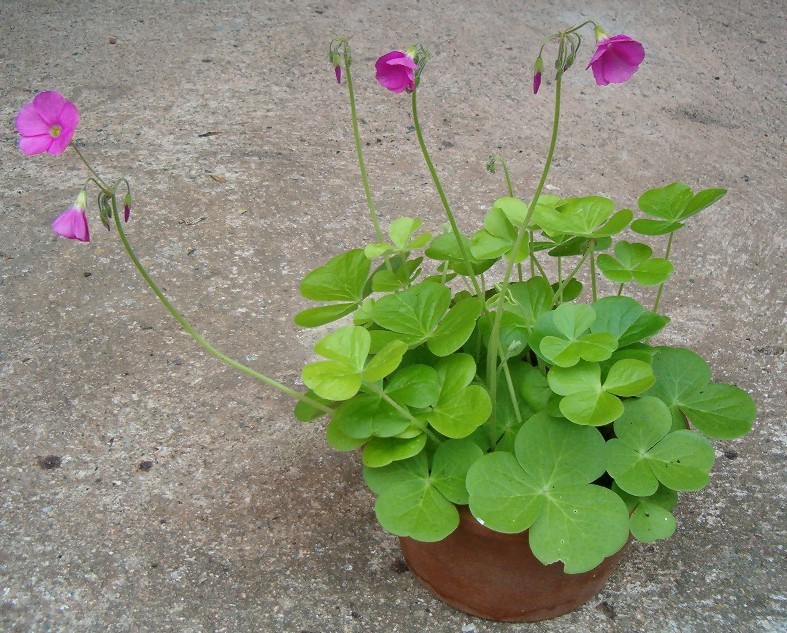 |
Oxalis bowiei flowers from September
onwards. The corms look like cloves of garlic. Everything about the
plant is a little larger than life.
After it has flowered I keep watering until the plant starts to
wither. Then I leave it be until June or so, turn the pot over, fish
out the corms, clean them up and replant them. Here in the south of
France it does quite well in the garden as well.
I was given a few corms, but you might find them at a special
market. They will rapidly increase. Rita van der Zalm this
year offered a variety named 'Amarantha' but the
nearly open bud does not look any different yet ...
|
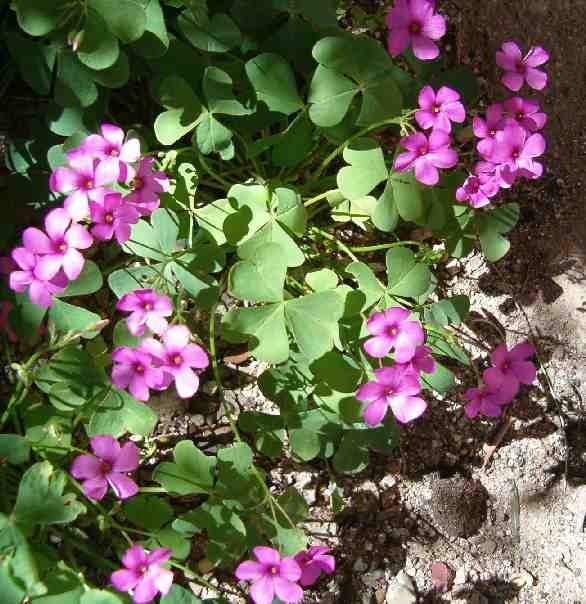 |
Oxalis rubra one of the very best! It
starts flowering in March, goes on till it becomes too hot, withers
and starts again in September. It is still at it at the beginning of
December this year, 2006!
They don't spread, but they do become larger. When you have to dig
up a plant for some reason you may find a long, carrot shaped white
root under the original bulb. Flowers can be used for cutting if you
need something for just a day or two.
I bought mine from Rita. You see them quite often here, but I
have so far never seen any for sale!
|
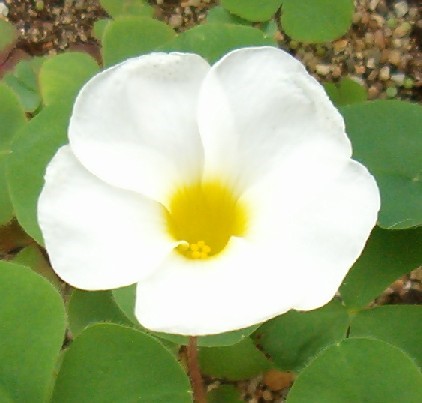 |
A gorgeous oxalis from South Africa: oxalis purpurea 'Alba'. It is flowering for the second time
now, late in autumn. This is just the first year I
have them, so I don't know yet how the winter will go.
I ordered white, but among the white was a lovely shell pink one and
also a darker pink flower. They are said to love a lot of sun.
From Capeseed.
|
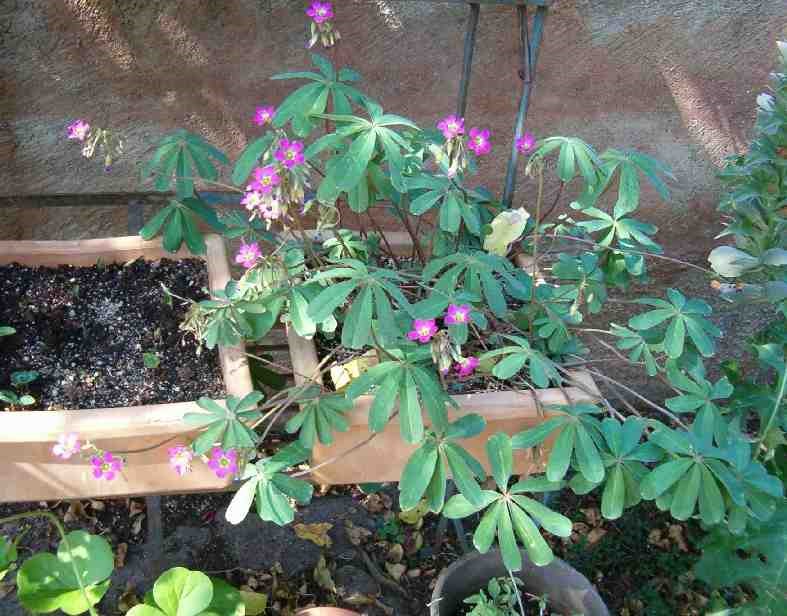 |
I have always loved oxalis lasiandra which
will grow easily in the garden too. The leaves are quite lovely,
chestnut shaped, and with freckles. They start flowering at the end
of summer.
I treat them the same way as oxalis bowiei. They spread here.
Not very difficult to find. Rita has them.
|
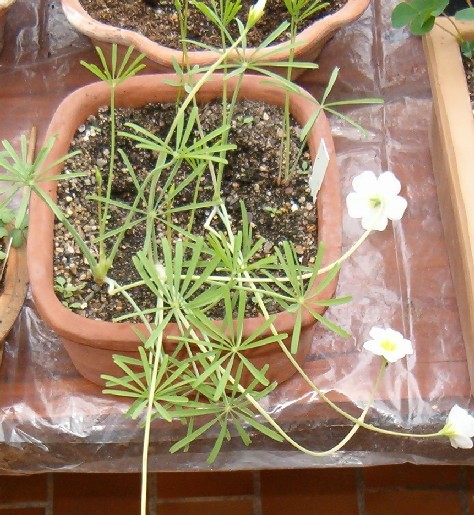 |
Living in the south of France I thought I could not
skip oxalis cathara. It has just started flowering,
but it looks rather floppy so I think I may have watered too well or
done wrong in another way. After arrival they developed leaves and
then died down. In autumn another set of leaves appeared, now with
buds. The leaves themselves are unusual in shape, reminding me of
oxalis lasiandra, but finer.
I read that I should plant them deep which I shall do after the
flowering season is over. Maybe they want another resting period:
they may have to adept to the northern hemisphere, who knows.
From Capeseed.
|
|
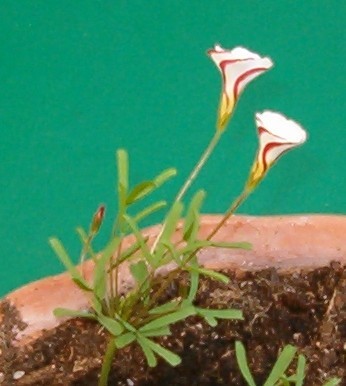
|
Oxalis versicolor does not allow itself
to be photographed all that easily. I would need a camera that can
do it from really close by ...This little toothpaste beauty has a
narrow red edge ('picotee). Bought from Rita and flowering now, end
of December, but maybe at another time next year. Originally from
South Africa. Flowers in the fall: 2007
|
|
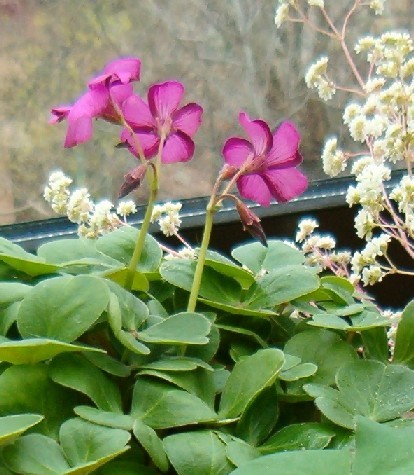
|
Oxalis brasiliensis has the same darker
edge to its petals. The leaves grow very close together and close to
the soil as well. This makes it into a more attractiveplant
than versicolor which is a little floppy, though the latter
looks much better when covered in flowers.
I had it in a green house in winter, so I don't know what is
going to happen in summer.
I know now, March 2008. It kept its leaves and is about to flower
again.
From Rita.
photo: 22nd February
The small white flowers in the background are crassula orbicularis rosea
...
|
|
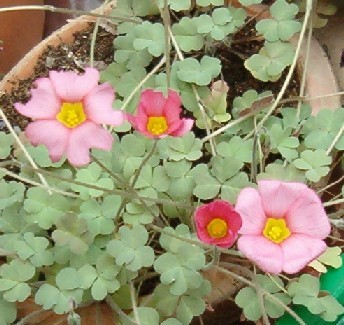
|
Oxalis obtusa. I had this one in a
greenhouse in winter, but it survives outdoors, but there it will
not flower. Though its leaves are nice and close cropped (can you
say that about leaves?) the flowers grow on long thin stems and
become quite untidy. In reality the colour of the flowers is more
orange. An insect has taken little mouthfuls from the buds,
fortunately it left some alone. Now that it is a littlge warmer I
open the windows and things enter the conservatory. Aphids have
arrived ...
From Rita.
photo: 22nd February
|
|
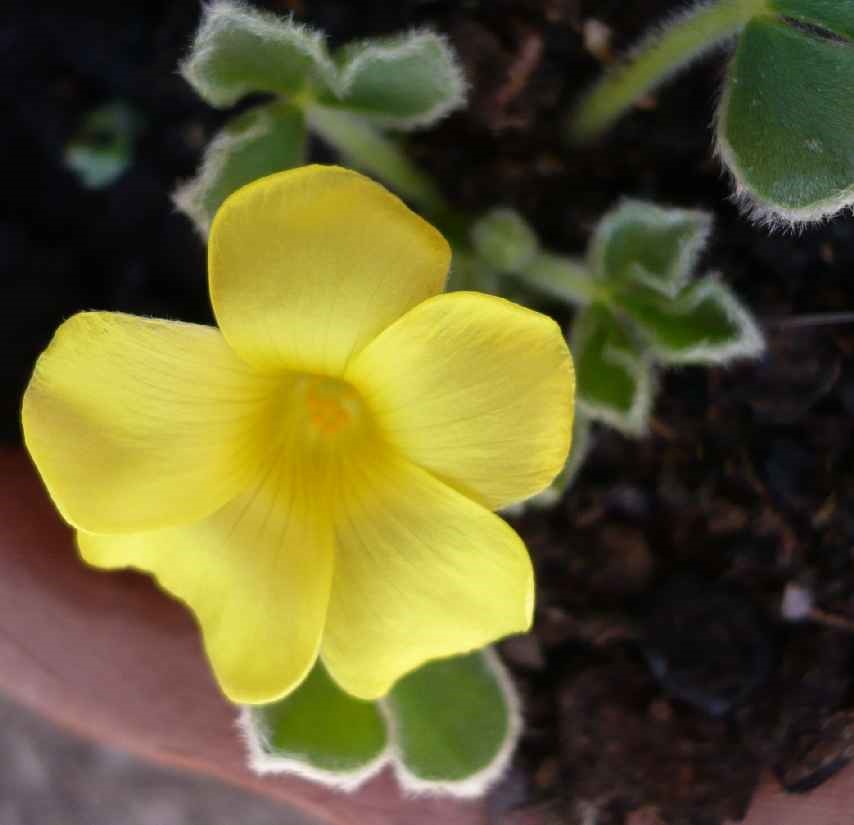
|
Oxalis melanostica. I had not seen its
flowers yet and was taken by surprise: the name suggested dark
flowers. It is the middle of September now. So far it has been hot
and dry for months. Halfway August I have started watering the pots
which had been kept dry in summer and soon enough little bits of
green appeared. Fortunately the tags were still legible.
Lovely leaves with their white fringes!
photo: 12th September 07 |
|
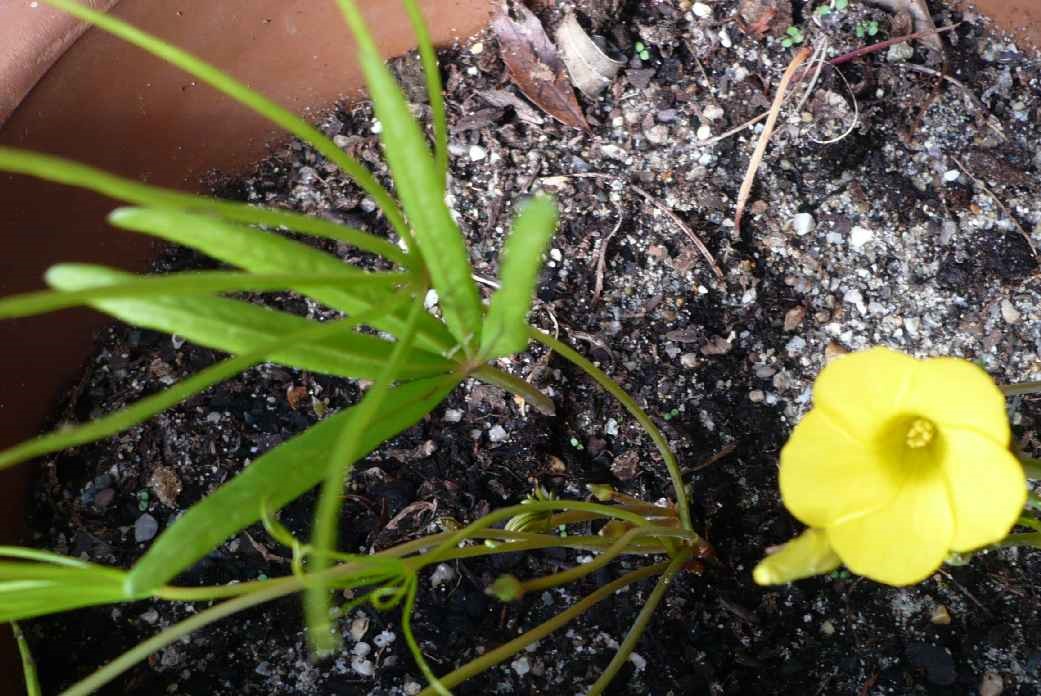
| From: Capeseed. photo: 2nd October; the
one on the right a little later, when the weather was a little
better. |
|
Oxalis flava The photo is
not all that good for the weather is pretty dark. I had read
somewhere that this oxalis is supposedly hard to get into flower. It
should be put in deep soil. So I replanted it into a large pot. Et
voilą: flowers! Yellow again, but that is to be expected with a
name like this ...The leaves are quite weird, large and spindly, 10
cms or more. From South Africa.
|
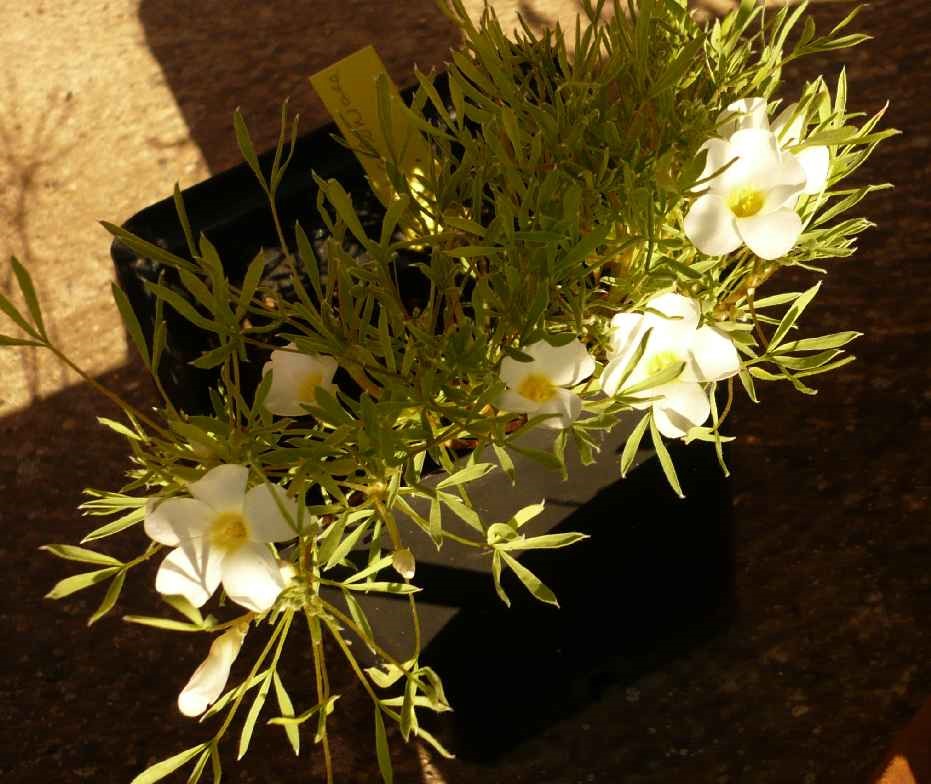 |
Oxalis massoniana I have gone through
só much trouble to lay my hands on this one! Ordered from New
Zealand and from South Africa where I found them at last, that is to
say after two years. Then I had to wait for flowers, two more years
and here they finally are: $%&®§„!!! Shit, shit, shit.
White instead of 'burnt orange', see photo somewhere on the bulbs
page. They have to stand on a saucer full of water during their
growing/flowering season. When finished they should be left baking
in the sun, no water.
From Capeseed.
Photo 14th October |
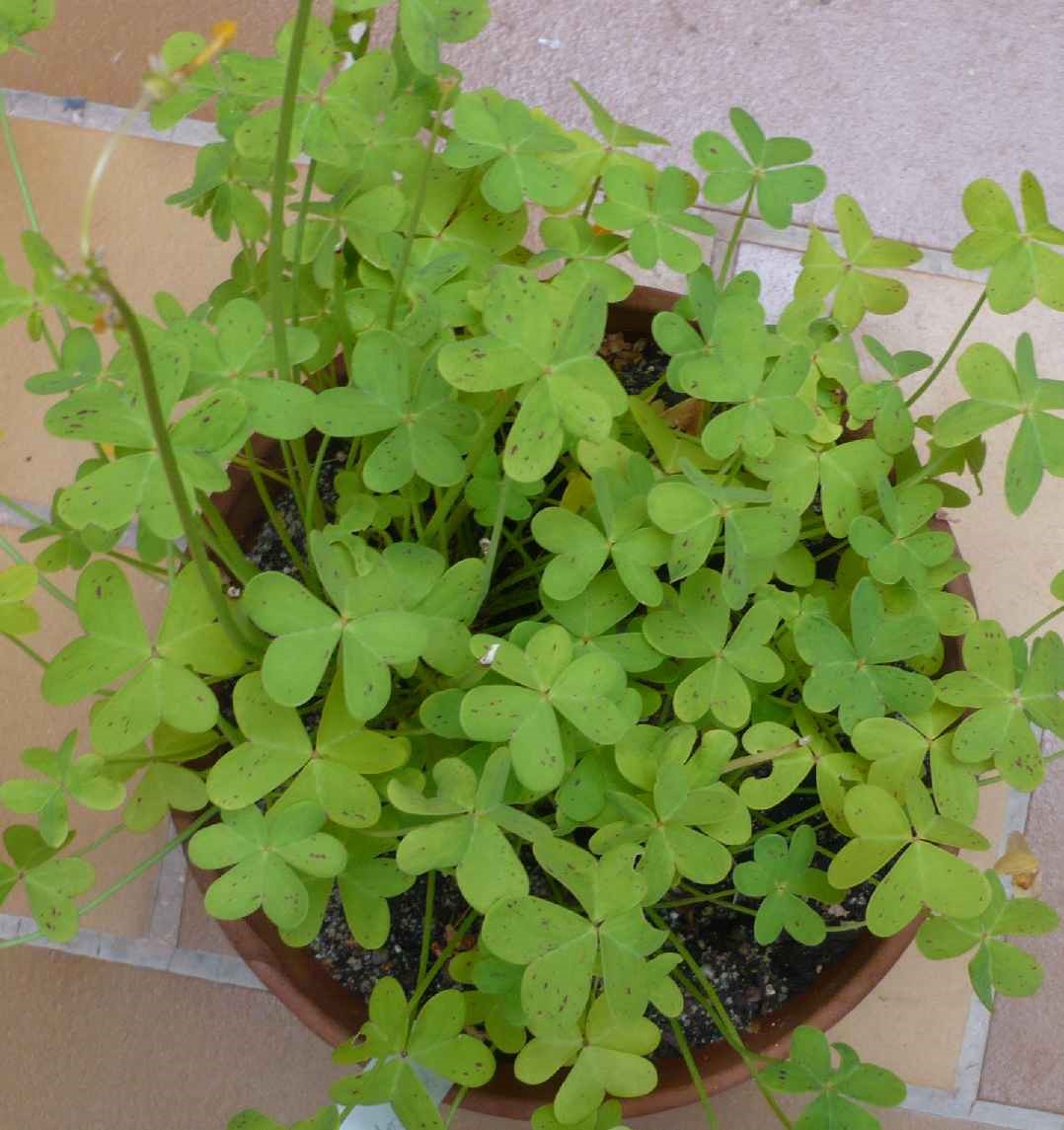 |
Oxalis pes-caprae I have been stupid: forgot to take a picture when it was in flower ... It has
the same kind of flowers as ox. dentata, yellow, but on longer
stems. I like this one's leaves with their brown freckles.
I got mine from Mr Gau, the owner of our local garden centre. He did
not give me bulbs or corms, but a few cuttings which he took straight
from the plant he had. They took a while to settle and longer to
bloom (last autumn, after two years).
I had a serious warning about this one: don't put it in your
garden as it is enormously invasive and not a native either. I
already suspect o. dentata of wanting to go all over the place and I
know by experience that o. depressa is quite invasive, so I try
keeping them in pots, but ... (I'll tell you later)
|
| |
|